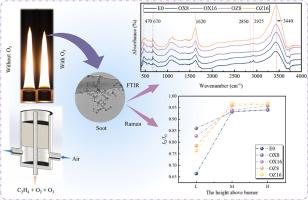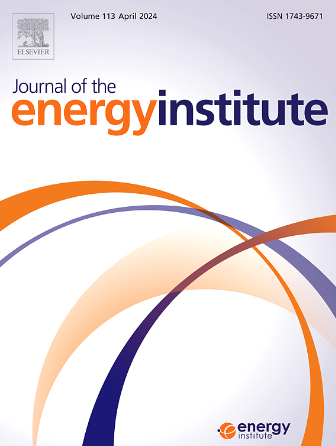臭氧和氧气稀释对同流乙烯/氧气/臭氧层流部分预混合火焰中烟尘形成的影响
IF 5.6
2区 工程技术
Q2 ENERGY & FUELS
引用次数: 0
摘要
臭氧具有极强的氧化性,是一种可用于增强和控制燃烧的添加剂。臭氧可以提高层流燃烧速度,扩大燃烧极限,改善火焰稳定性,但臭氧对碳氢化合物燃料燃烧过程中烟尘形成的影响尚不明确。因此,研究了乙烯/氧气/臭氧层状部分预混合火焰产生的烟尘。此外,还研究了烟尘形成对不同稀释气体比例的响应规律,以及臭氧参与反应的影响。研究发现,在稀释比为 10% 的情况下,臭氧能明显缩短火焰高度 4 毫米。由于臭氧参与燃烧,烟尘的粒径在中低火焰高度时更大。主要原因是臭氧促进了烟尘的生长。在中高火焰高度下,氧气和臭氧的比例越大,烟尘的石墨化程度越低。氧气和臭氧的加入都使 ID/IG 值增加,表明石墨化程度降低。稀释比为 10%、添加了臭氧的火焰高度烟尘的 ID/IG 值最大,为 0.970,表明其石墨化程度很低。加入氧气和臭氧后,高火焰高度烟尘表面含氧官能团的信号强度增强。本文章由计算机程序翻译,如有差异,请以英文原文为准。

Effect of ozone and oxygen dilution on soot formation in coflow ethylene/oxygen/ozone laminar partially premixed flames
Ozone is a prospective additive for enhancing and controlling combustion, due to its extremely oxidizing property. Ozone can enhance laminar burning velocity, broaden the flammability limit and improve flame stability, but the effect of ozone on soot formation in the combustion process of hydrocarbon fuels was not yet clear. Therefore, the soot from ethylene/oxygen/ozone laminar partially premixed flames was investigated. Besides, the response law of soot formation to different dilution gas ratios, and the effect of ozone participation in the reaction was also investigated. This work found that ozone significantly shortened the flame height by 4 mm in the cases of 10 % dilution ratio. The particle size of soot was larger at low and medium flame heights due to ozone involved in combustion. The main reason was that ozone promoteed soot growth. At medium and high flame heights, the larger the percentage of oxygen and ozone, the lower graphitization degree of the soot. The addition of oxygen and ozone both made the ID/IG value increase, which indicated the graphitization degree decreased. The soot from high height of the flame with 10 % dilution ratio and the addition of ozone had the largest ID/IG value of 0.970, which indicated a very low degree of graphitization. The signal intensity of the oxygen-containing functional groups on the surface of soot at the high flame height was enhanced with the addition of oxygen and ozone to the reaction.
求助全文
通过发布文献求助,成功后即可免费获取论文全文。
去求助
来源期刊

Journal of The Energy Institute
工程技术-能源与燃料
CiteScore
10.60
自引率
5.30%
发文量
166
审稿时长
16 days
期刊介绍:
The Journal of the Energy Institute provides peer reviewed coverage of original high quality research on energy, engineering and technology.The coverage is broad and the main areas of interest include:
Combustion engineering and associated technologies; process heating; power generation; engines and propulsion; emissions and environmental pollution control; clean coal technologies; carbon abatement technologies
Emissions and environmental pollution control; safety and hazards;
Clean coal technologies; carbon abatement technologies, including carbon capture and storage, CCS;
Petroleum engineering and fuel quality, including storage and transport
Alternative energy sources; biomass utilisation and biomass conversion technologies; energy from waste, incineration and recycling
Energy conversion, energy recovery and energy efficiency; space heating, fuel cells, heat pumps and cooling systems
Energy storage
The journal''s coverage reflects changes in energy technology that result from the transition to more efficient energy production and end use together with reduced carbon emission.
 求助内容:
求助内容: 应助结果提醒方式:
应助结果提醒方式:


